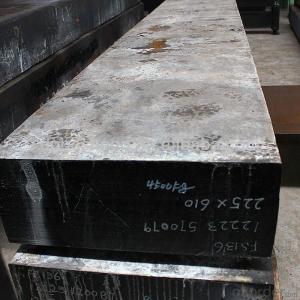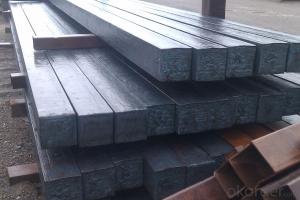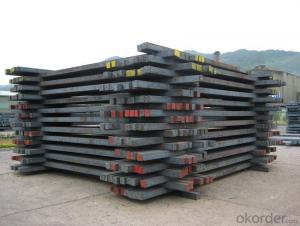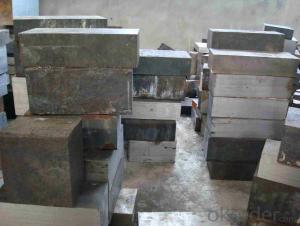Prime Q275 115mm Square Alloy Steel Billet
- Loading Port:
- Shanghai
- Payment Terms:
- TT OR LC
- Min Order Qty:
- 100 m.t.
- Supply Capability:
- 10000 m.t./month
OKorder Service Pledge
OKorder Financial Service
You Might Also Like
Structure of Prime Q275 115mm Square Alloy Steel Billet

Description of Prime Q275 115mm Square Alloy Steel Billet
1. Prepainted steel coil is coated with organic layer, which provides higher anti-corrosion property and a longer lifespan than that of galvanized or galvalume steel sheets.
2. The base metals for prepainted steel coil consist of cold rolled, HDGI Steel, electro-galvanized and hot-dip alu-zinc coated steel. The finish coats of prepainted steel coil can be classified into groups as follows: polyester, silicon modified polyesters, polyvinylidene fluoride, high-durability polyester, etc.
3. The production process has evolved from one-coating-and-one-baking to double-coating-and-double-baking, and even three-coating-and-three-baking.
4. The color of the prepainted steel coil has a very wide selection, like orange, cream-colored, dark sky blue, sea blue, bright red, brick red, ivory white, porcelain blue, etc.
5. The prepainted steel coils can also be classified into groups by their surface textures, namely regular prepainted sheets, embossed sheets and printed sheets.

Main Feature of Prime Q275 115mm Square Alloy Steel Billet
Uncoated CR steel sheet
With the features of in line with the international highest standards in demension and shape, excellent surface finish and properties, the products are mainly used in home appliance and automobile industries.
Galvanized steel sheet(include HDG and EG)
With the features of good corrosion resistance, the products are mainly used in automobile, home appliance, electronics, building and machinery manufacture industries, etc.
Precoated steel sheet
With the features of enviromental protection and good processablility, long lasting surface durability, rich in colors, the products are maily used in building, home appliance and furniture industries, etc.
Applications of Prime Q275 115mm Square Alloy Steel Billet
A. Corrugated design makes it excellent waterproof performance
B. Materials as prepainted steel sheets, galvanized steel sheets, galvalume (Al-Zn coated sheets) are available to make corrugated sheet.
C.Those material are durable, anti-corrosion in bad weather for 20-30 years based on it's Zinc(Galvanized) coating or AZ (Galvalume) coating.
D. Different shape of the sheet make it suitable for any style of buildings.
E.Easy to install, no need special tools to fix the sheet.
F.Light weight due to high strength to weight ratio of steel. Light weight means easier handling lower shipping costs, easier installation
G. Different color is availbe base on the RAL Standard make your building more beautiful.
H. We will provide the best solutions if you don't have a exact idea of the specification you want for the steel sheet based on your weather conditions, engineering structure, construction budget and so on.

Specifications of Prime Q275 115mm Square Alloy Steel Billet
Product | Billet |
Material Grade | SGCC / SGCH / DX51D+AZ, etc |
Thickness | 0.6-3.0mm |
Width | 500-1500mm |
Tolerance | Thickness: +/-0.02mm , Width:+/-2mm |
Zinc-coating | Z30-150g/m2 |
Technique | Raw material: Hot rolled steel coil --> Cold rolled_>hot dipped galvalume |
Surface | Dried, Chromated, Unoiled |
Spangle | Regular spangle , small spangle, zero spangle |
ID | 508MM 610MM |
Coil weight | 1-25MT |
Export package | Cardboard inner sleeves, Waterproof paper, galvanized steel covered and steel strip packed |
FAQ of Prime Q275 115mm Square Alloy Steel Billet
We have organized several common questions for our clients,may help you sincerely:
1. How Can I Visit There?
Our company is located in Tianjin City, China, near Beijing. You can fly to Tianjin Airport Directly. All our clients, from home or aboard, are warmly welcome to visit us!
2. How Can I Get Some Sample?
We are honored to offer you sample.
3. Why choose CNBM?
Our delivery time about 15-20days for standard sizes, if you have other requirements like hardness, quanity and width ,it is about 20-40days. But don't worry we also try our best for the delivery time ,because time longer and our cost is higher.
- Q:What is the typical composition of a steel billet?
- The typical composition of a steel billet consists of iron as the primary element, along with a small percentage of carbon, manganese, silicon, and trace amounts of other elements such as sulfur and phosphorus.
- Q:What are the different methods of steel billet surface treatment?
- The industry commonly utilizes several methods for steel billet surface treatment, aiming to enhance properties such as corrosion resistance, hardness, and aesthetics. Some of the most widely used methods include: 1. Pickling and Passivation: By utilizing acid solutions, impurities and oxide layers are removed from the steel surface. Passivation follows pickling to create a protective layer against future corrosion. 2. Shot Blasting: This mechanical treatment involves bombarding the billet surface with high-speed steel shots or grits, effectively eliminating scale, rust, and contaminants to achieve a clean and uniform surface. 3. Hot-Dip Galvanizing: Steel billets are immersed in molten zinc, which forms a protective coating on the surface. This method provides exceptional corrosion protection, making it suitable for outdoor applications. 4. Electroplating: A thin layer of metal, such as chrome or nickel, is deposited onto the steel surface using an electric current. This process enhances appearance, corrosion resistance, and wear resistance. 5. Powder Coating: A dry powder is applied to the steel surface and then cured through heat, resulting in a durable and visually appealing finish. This method is popular for aesthetic purposes. 6. Painting: The steel surface is cleaned, primed, and applied with a suitable paint system. This method enhances appearance and provides protection against corrosion and environmental factors. 7. Nitriding: Nitrogen diffuses into the steel surface through a heat treatment process. This method improves billet hardness, wear resistance, and fatigue strength. These are just a few of the available methods for steel billet surface treatment. The choice of method depends on specific application requirements, desired properties, and budget considerations.
- Q:How do steel billets contribute to the manufacturing of consumer goods?
- Steel billets are a crucial raw material in the manufacturing of consumer goods as they serve as the base material for various steel products. These billets are used in processes such as forging, rolling, and extrusion to produce a wide range of consumer goods, including appliances, automobiles, construction materials, and machinery. The versatility, strength, and durability of steel make it an ideal choice for manufacturing consumer goods, and steel billets form the foundation for creating these high-quality and long-lasting products.
- Q:What are the different methods of shaping steel billets?
- There are several methods of shaping steel billets, including hot rolling, cold rolling, forging, extrusion, and casting. Each method involves different techniques and processes to shape the steel billets into desired forms and dimensions.
- Q:What does the billet of the steel plant refer to?
- The steel billet is the continuous casting machine by smelting steel plant casting into the blank, in the middle of products before entering the rolling process, the section size will be decided by rolling steel.
- Q:What are the factors that affect the price of steel billets?
- There are several factors that can affect the price of steel billets. 1. Raw material costs: The cost of iron ore, coal, and other raw materials used in steel production can significantly impact the price of steel billets. Any fluctuations in these costs can directly influence the price of steel billets. 2. Demand and supply: The supply and demand dynamics of steel billets play a crucial role in determining their price. An increase in demand for steel products, such as construction materials or automotive parts, can drive up the price of steel billets. Conversely, an oversupply of steel billets can lead to a decrease in price. 3. Energy costs: The cost of energy, including electricity and fuel, required for steel production can impact the price of steel billets. Fluctuations in energy prices can affect the overall production cost and, subsequently, the price of steel billets. 4. Currency exchange rates: Steel billets are often traded on international markets, and currency exchange rates can have a significant impact on their price. If the currency of the country producing steel billets weakens against other currencies, it can make the product more affordable and potentially increase demand. 5. Trade policies and tariffs: Government regulations, trade policies, and tariffs imposed on steel billets can influence their price. Tariffs can increase the cost of imported steel billets, making domestically produced steel billets relatively more competitive and potentially leading to higher prices. 6. Economic factors: The overall state of the economy, both locally and globally, can impact the price of steel billets. During periods of economic growth, there is typically higher demand for steel products, which can drive up the price of steel billets. Conversely, during economic downturns, demand may decrease, resulting in lower prices. 7. Technological advancements: Innovations in steel production technology can impact the price of steel billets. Advancements that increase efficiency and reduce production costs can potentially lead to lower prices, while new technologies that improve the quality or properties of steel billets may command a higher price. It is important to note that these factors are interconnected and can influence each other. Therefore, understanding the complex relationship between these factors is essential in analyzing and predicting the price of steel billets.
- Q:What are the different surface treatments applied to alloy steel billets?
- Some of the different surface treatments applied to alloy steel billets include hot rolling, cold drawing, peeling, grinding, and polishing. These treatments are used to improve the surface finish, dimensional accuracy, and overall quality of the billets.
- Q:What are the potential applications of steel billets in the aerospace industry?
- Steel billets have a wide range of potential applications in the aerospace industry. One of the primary uses of steel billets in this industry is for the production of structural components. Steel billets can be forged or machined into various shapes and sizes to create strong and durable parts such as beams, brackets, and frames. Another important application of steel billets in aerospace is for the manufacturing of landing gear components. Landing gear systems require materials that can withstand high levels of stress and fatigue, and steel billets offer excellent strength and toughness properties, making them ideal for this purpose. Steel billets can also be used in the production of engine components. The aerospace industry requires materials that can withstand extreme temperatures and maintain their mechanical properties under high stress conditions. Steel billets can be heat-treated to enhance their resistance to heat and corrosion, making them suitable for use in engine parts such as turbine blades, shafts, and casings. Furthermore, steel billets can be utilized in the construction of fuel systems and hydraulic systems. These systems often require components that can handle high pressure and are resistant to corrosion. Steel billets can be machined into fittings, connectors, and valves that meet these requirements, ensuring the safety and reliability of these crucial systems. Overall, the potential applications of steel billets in the aerospace industry are vast and diverse. From structural components to landing gear systems, engine parts, and fuel systems, steel billets offer the necessary strength, durability, and resistance properties required for the demanding conditions of aerospace operations.
- Q:How are steel billets used in the production of turbine blades?
- Turbine blades rely heavily on steel billets, which serve as a fundamental building block in their production. These billets, essentially semi-finished steel products, serve as the initial material for the manufacturing process. To commence, the selection of steel billets is a meticulous process, taking into account specific requirements such as composition, strength, and durability. Once chosen, the billets undergo a series of processing steps to transform them into turbine blades. The initial step involves subjecting the steel billets to high temperatures in a furnace, a process known as forging. This procedure enhances the malleability of the steel, making it easier to work with. Once heated, the billets are then shaped into turbine blades through the application of mechanical forces. Following the initial forging process, the turbine blades are refined through a range of machining operations. These operations encompass precision cutting, grinding, and drilling, all aimed at achieving the desired dimensions, surface finish, and aerodynamic profiles. Aside from shaping and refinement, steel billets also play a pivotal role in strengthening and ensuring the integrity of turbine blades. Through heat treatment processes like quenching and tempering, the billets are hardened and tempered, resulting in desired mechanical properties such as high strength and resistance to fatigue. Moreover, steel billets provide the necessary material properties to withstand the harsh operating conditions of turbines. They exhibit excellent corrosion resistance, a crucial attribute for blades operating in environments with high temperatures, pressure, and moisture. In summary, steel billets are indispensable in turbine blade production as they serve as the starting material, facilitate shaping and refinement, and offer the required strength and durability for these critical components in power generation.
- Q:How are steel billets used in the production of railway wheels?
- Steel billets are an indispensable element for manufacturing railway wheels. These billets, which are essentially semi-finished forms of steel, serve as the initial stage of the production process. To begin the production of railway wheels, the steel billets are subjected to high temperatures in a furnace. This heating process, known as hot rolling, enhances the steel's malleability and ductility, making it easier to shape. Once the billets have reached the desired temperature, they undergo a series of rolling operations. These operations gradually shape the billets into the required size and form for railway wheels. High pressure is applied to the billets during this rolling process, causing them to elongate and take on the desired shape. After the rolling process, the shaped billets undergo further processing to eliminate any excess material and refine the surface finish. This step ensures that the final product meets all the necessary specifications for railway wheels. Lastly, the shaped billets are sent for additional machining, where they are turned, drilled, and finished to create the final railway wheel. This machining process is essential in achieving the required dimensions, balance, and surface quality needed for safe and efficient operation. In conclusion, steel billets play a vital role in the production of railway wheels. They are heated, rolled, shaped, and further processed to create the essential components for the final product. Without steel billets, the production of railway wheels would not be feasible.
1. Manufacturer Overview |
|
|---|---|
| Location | |
| Year Established | |
| Annual Output Value | |
| Main Markets | |
| Company Certifications | |
2. Manufacturer Certificates |
|
|---|---|
| a) Certification Name | |
| Range | |
| Reference | |
| Validity Period | |
3. Manufacturer Capability |
|
|---|---|
| a)Trade Capacity | |
| Nearest Port | |
| Export Percentage | |
| No.of Employees in Trade Department | |
| Language Spoken: | |
| b)Factory Information | |
| Factory Size: | |
| No. of Production Lines | |
| Contract Manufacturing | |
| Product Price Range | |
Send your message to us
Prime Q275 115mm Square Alloy Steel Billet
- Loading Port:
- Shanghai
- Payment Terms:
- TT OR LC
- Min Order Qty:
- 100 m.t.
- Supply Capability:
- 10000 m.t./month
OKorder Service Pledge
OKorder Financial Service
Similar products
New products
Hot products
Related keywords
































